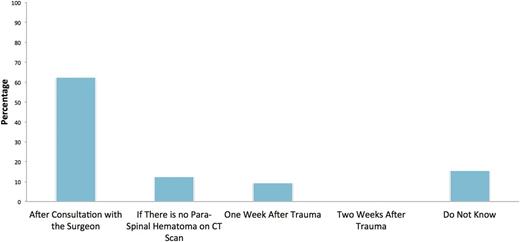Abstract
Background: Patients with acute spinal cord injury (SCI) have a 10-30% risk of venous thromboembolism despite prophylaxis, with the highest incidence 7-14 days after injury. The prophylaxis method recommended by the American College of Chest Physicians (ACCP) guidelines is low-molecular weight heparin (LMWH) for 90 days. However, the optimal timing of starting LMWH after acute SCI is unknown and is challenging due to the balance against bleeding and the need for frequent surgical procedures in the first 2 weeks after injury.
Aims: 1) To determine whether there is a consensus among spine surgeons about the optimal timing of commencing LMWH, and 2) to assess their knowledge about the current standard of care thromboprophylaxis and the recommended duration.
Methods: A short 5-question electronic survey was sent to the spine surgeons from the Canadian Spine Society. The questions included demographic information about their profession and numbers of years in practice; the recommended prophylaxis type and duration by ACCP; and the optimal timing of starting LMWH after acute SCI.
Results: A total of 32 responses were received to date: 31 from spine surgeons and 1 from a neurosurgeon. The completion rate was 88%. The median duration of years in practice was 10.5 years (range 2 to 40 years). Most of the respondents (26 of 32; 81%) correctly identified that the currently recommended prophylaxis by ACCP is LMWH. However, only 10 respondents (31%) correctly identified that the recommended duration of prophylaxis is 90 days. Interestingly, most of the spine surgeons (20 of 32; 62.5%) recommended a consultation with the surgeon prior to starting LMWH. Four (12.5%) recommended starting LMWH if there is no para-spinal hemotoma on the computerized tomography scan; 3 (9.4%) recommended waiting for a week after acute SCI; and the rest (15.6%) indicated that they do not know the optimal timing of starting LMWH after acute SCI. None of the respondents selected the option of waiting for 2 weeks after acute SCI before starting LMWH.
Conclusions: The data from our survey suggests that most spine surgeons are comfortable with starting LMWH after a consultation with the surgeon. Furthermore, the knowledge base about thromboprophylaxis in this high-risk population was variable. A multi-national cross-sectional study can further explore the knowledge among spine surgeons about the optimal timing of starting thromboprophylaxis after acute SCI.
Figure 1. The optimal timing of starting prophylaxis with LMWH after acute spinal cord injury
No relevant conflicts of interest to declare.
Author notes
Asterisk with author names denotes non-ASH members.


This feature is available to Subscribers Only
Sign In or Create an Account Close Modal